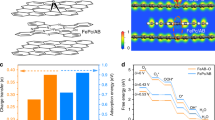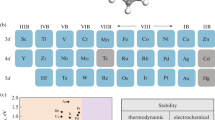Abstract
The oxygen reduction reaction (ORR) catalyzed by mononuclear and planar binuclear cobalt (CoPc) and iron phthalocyanine (FePc) catalysts is investigated in detail by density functional theory (DFT) methods. The calculation results indicate that the ORR activity of Fe-based Pcs is much higher than that of Co-based Pcs, which is due to the fact that the former could catalyze 4e- ORRs, while the latter could catalyze only 2e- ORRs from O2 to H2O2. The original high activities of Fe-based Pcs could be attributed to their high energy level of the highest occupied molecular orbital (HOMO), which could lead to the stronger adsorption energy between catalysts and ORR species. Nevertheless, the HOMO of Co-based Pcs is the ring orbital, not the 3d Co orbital, thereby inhibiting the electron transfer from metal to adsorbates. Furthermore, compared with mononuclear FePc, the planar binuclear FePc has more stable structure in acidic medium and more suitable adsorption energy of ORR species, making it a promising non-precious electrocatalyst for ORR.
Similar content being viewed by others
References
Z. Chen, D. Higgins, A. Yu, L. Zhang, and J. Zhan., Energy Environ. Sci. 4, 3167 (2011).
M. Lefèvre, E. Proietti, F. Jaouen, and J. P. Dodele., Science 324, 71 (2009).
R. Bashyam and P. Zelena., Nature 443, 63 (2006).
G. Wu, K. L. More, C. M. Johnston, and P. Zelena., Science 332, 443 (2011).
X. Chen, F. Li, X. Wang, S. Sun, and D. Xi., J. Phys. Chem. C 116, 12553 (2012).
L. Qu, Y. Liu, J. B. Baek, and L. Dai, ACS Nano 4, 1321 (2010).
F. Jaouen, E. Proietti, M. Lefèvre, R. Chenitz, J. P. Dodelet, G. Wu, H. T. Chung, C. M. Johnston, and P. Zelena., Energy Environ. Sci. 4, 114 (2011).
X. Chen, Q. Qiao, L. An, and D. Xi., J. Phys. Chem. C 119, 11493 (2015).
R. Chen, H. Li, D. Chu, and G. Wan., J. Phys. Chem. C 113, 20689 (2009).
L. N. Ramavathu, K. K. Maniam, K. Gopalram, and R. Chett., J. Appl. Electrochem. 42, 945 (2012).
M. R. Hempstead, A. B. P. Lever, and C. C. Leznof., Can. J. Chem. 65, 2677 (1987).
E. Vayner and A. B. Anderso., J. Phys. Chem. C 111, 9330 (2007).
G. te Velde, F. M. Bickelhaupt, E. J. Baerends, C. Fonseca Guerra, S. J. A. van Gisbergen, J. G. Snijdersand, and T. Ziegle., J. Comput. Chem. 22, 931 (2001).
C. Fonseca Guerra, J. G. Snijders, G. te Velde, and E. J. Baerend., Theor. Chem. Acc. 99, 391 (1998).
Theoretical Chemistry, Vrije Universiteit, Amsterdam, The Netherlands. http://www.scm.com.
C. Lee, W. Yang, and R. G. Par., Phys. Rev. B 37, 785 (1988).
S. Kattel, P. Atanassov, and B. Kiefe., Phys. Chem. Chem. Phys. 15, 148 (2013).
A. B. Anderson and T. V. Alb., J. Electrochem. Soc. 147, 4229 (2000).
X. Chen, S. Sun, F. Li, X. Wang, and D. Xi., Molecules 18, 3279 (2013).
T. Jacob and W. A. Goddar., ChemPhysChem 7, 992 (2006).
Y. Sha, T. H. Yu, Y. Liu, B. V. Merinov, and W. A. Goddar., J. Phys. Chem. Lett. 1, 856 (2010).
F. A. Uribe and T. A. Zawodzinsk., Electrochim. Acta 47, 3799 (2002).
A. Lyalin, A. Nakayama, K. Uosaki, and T. Taketsug., Phys. Chem. Chem. Phys. 15, 2809 (2013).
J. A. Keith and T. Jaco., Angew. Chem. Int. Ed. 49, 9521 (2010).
J. Roques and A. B. Anderson, J. Fuel Cell Sci. Technol. 2, 86 (2005).
Y. Sun, K. Chen, L. Jia, and H. L., Phys. Chem. Chem. Phys. 13, 13800 (2011).
Z. Shi and J. Zhan., J. Phys. Chem. C 111, 7084 (2007).
M. S. Liao and S. Scheine., J. Comput. Chem. 23, 1391 (2002).
Author information
Authors and Affiliations
Corresponding author
Additional information
The article is published in the original.
Rights and permissions
About this article
Cite this article
Chen, X., Li, M., Yu, Z. et al. A comparative DFT study of oxygen reduction reaction on mononuclear and binuclear cobalt and iron phthalocyanines. Russ. J. Phys. Chem. 90, 2413–2417 (2016). https://doi.org/10.1134/S0036024416120323
Received:
Published:
Issue Date:
DOI: https://doi.org/10.1134/S0036024416120323




